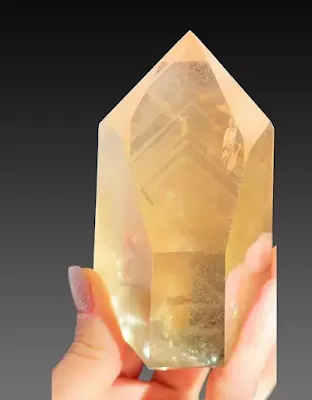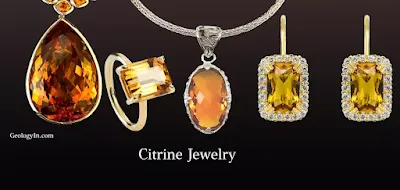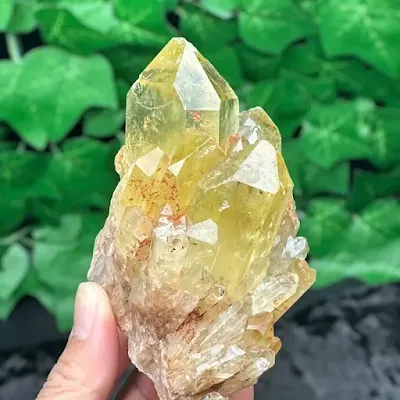Citrine: Crystals, Properties, Uses, Birthstone
Citrine is a beautiful yellow to orange-colored variety of quartz. Citrine ranges in color from pale yellow to golden yellow, honey yellow, and brownish orange. The most desirable citrines have a rich, saturated yellow or orange color with good transparency. It is one of the most popular gemstones for jewelry due to its affordability, durability, and attractive colors. Citrine is the birthstone for November, along with topaz.
When the quartz undergoes heat treatment or natural irradiation, it can deepen the yellow hue, sometimes resembling the color of topaz. Unlike amethyst, which gets its purple color from iron impurities, citrine's yellow to orange tones are due to the presence of different oxidation states of iron. Natural citrine is relatively rare, and most citrine on the market today is actually amethyst or smoky quartz that has been heat-treated to achieve its golden color.
Citrine has been attributed with various symbolic meanings throughout history. Ancient Egyptians associated it with the sun god Ra, believing it to possess life-giving properties. Greeks and Romans linked the stone to wealth and prosperity. Modern interpretations often focus on citrine's ability to promote optimism, creativity, and abundance.
 |
| Citrine |
Citrine Color
Citrine, a yellow variety of quartz, exhibits a color range from pale yellow to deep golden brown. This coloration is attributed to the presence of trace amounts of ferric iron (Fe³⁺) ions substituting for silicon (Si⁴⁺) within the crystal lattice.
The specific color of a citrine specimen is directly related to the concentration and distribution of these iron impurities. Higher concentrations of Fe³⁺ ions result in deeper, more saturated yellow hues, approaching an orange color. Conversely, lower concentrations produce paler shades of yellow.
Heat treatment can enhance the existing yellow coloration or even transform other quartz varieties, such as amethyst or smoky quartz, into citrine by altering the oxidation state of iron impurities. This process can create a more consistent golden yellow color that is commercially desirable.
Citrine Properties
Composition: Like all quartzes, citrine is silicon dioxide (SiO₂) - the most abundant mineral in Earth's crust.
Color: Citrine's sunshine-like hues range from pale yellow to a fiery reddish orange.
Transparency: Citrine can be transparent, allowing light to pass through completely, or translucent, where light partially penetrates the stone.
Luster: Vitreous (glassy), resembling the glassy shine of high-quality glass.
Crystal System: Citrine belongs to the trigonal crystal system, characterized by a three-fold rotational symmetry axis and specific crystallographic angles.
Hardness and Durability: Citrine ranks 7 on the Mohs scale of mineral hardness. This makes it relatively hard and durable, suitable for everyday wear in jewelry.
Cleavage: None (poor)
Fracture: Conchoidally, meaning it breaks into smooth, curved surfaces resembling the inside of a seashell.
Habits and Forms: Citrine occurs naturally in a variety of forms, including well-defined crystals, clusters of intergrown crystals (druses), and massive (shapeless) aggregates.
Density and Specific Gravity: Citrine has a density of 2.65 grams per cubic centimeter (g/cm³). This specific gravity is a useful identifier for gemologists, as different minerals have distinct density values.
Tenacity and Brittleness: While relatively hard, citrine is brittle. This means it can shatter or chip if struck with enough force.
Chemical Properties: Citrine is insoluble in water. However, it can slightly dissolve in hydrofluoric acid, a powerful solvent used in industrial settings.
Magnetism: Citrine is non-magnetic, meaning it is not attracted to magnets.
Fluorescence: Some citrine exhibits a weak yellow or orange fluorescence under shortwave ultraviolet (UV) light. This can be a helpful identification tool for gemologists.
Pleochroism: Citrine may exhibit weak pleochroism. This means the color might appear slightly different depending on the viewing direction. The color variation is usually subtle but can be detected by trained gemologists.
Refractive Index: The refractive index (RI) is a measure of how light bends as it passes through a material. Citrine has a refractive index ranging from 1.544 to 1.554. Natural citrine may have a slightly higher RI compared to heat-treated varieties.
Inclusions: Liquid inclusions, gas bubbles, phantoms (internal growth patterns). Natural gemstones often contain inclusions, tiny internal features like feather fractures (hairline cracks), liquid inclusions (microscopic bubbles), or phantoms (internal growth patterns). These inclusions can sometimes be used to differentiate natural stones from synthetic ones.
 |
| Natural citrine from Aracuai, Minas Gerais, Brazil. Photo: davikminerals |
Rarity
Compared to amethyst or smoky quartz, which are more abundant, the specific conditions required for natural citrine formation make it less common. Additionally, some factors can hinder its development:
- Heat: Not just any heat. Natural geothermal heating within the Earth's crust can play a role in creating the yellow color.
- Radiation: Exposure to natural radiation sources can also contribute to the development of the yellow hue.
Due to the specific requirements for its formation, natural citrine exhibits a more limited geographical distribution compared to other quartz varieties.
Citrine Occurrences and Localities
While uncommon, natural citrine can be found in specific geological environments conducive to the presence of the necessary elements and conditions. Here are some primary geological settings where natural citrine formation is more likely:
Igneous Intrusions: Notably pegmatites, these are coarse-grained igneous rocks formed through the slow cooling of silica-rich magma. Pegmatites can contain cavities where hydrothermal fluids circulate. These fluids may deposit quartz crystals containing the requisite iron impurities for subsequent citrine formation.
Hydrothermal Veins: These are mineral deposits that arise when hot, mineral-rich water travels through fractures and fissures within rocks. As the water cools and pressure decreases, dissolved minerals can precipitate, potentially including quartz crystals containing ferric iron. Under suitable conditions, these crystals can then transform into citrine.
Geodes: These hollow rock cavities, often lined with crystals, can provide another environment for natural citrine formation. Within geodes, citrine can crystallize as druses, which are aesthetically pleasing clusters of crystals.
 |
Citrine geodes are heated treated amethyst geodes to turn them yellow or orange, |
Where is Citrine Found
Geographic Distribution of Natural Citrine:
Natural Citrine occurs in limited quantities around the world. Here are some of the notable localities where natural citrine can be found:
Brazil: Brazil is one of the primary sources of citrine, particularly the state of Rio Grande do Sul. Citrine is commonly found in association with amethyst in geodes and cavities within volcanic rocks in this region. The Serra Geral Formation is known for producing high-quality citrine crystals.
Madagascar: Madagascar is another significant producer of citrine. Deposits are found in various regions across the country, including the Antsiranana, Antananarivo, and Toliara provinces. Citrine from Madagascar often exhibits rich golden hues and is highly valued in the gemstone market.
United States: Citrine can be found in several states within the U.S., including Colorado, North Carolina, and California. In Colorado, citrine is often found alongside amethyst in pegmatite veins. North Carolina is known for producing citrine in association with smoky quartz in the western part of the state. California also has deposits of citrine, particularly in the San Bernardino Mountains.
Spain: Spain has notable citrine deposits, particularly in the Catalonian region. Citrine crystals from Spain are often found in granite pegmatites and are known for their clarity and intense yellow coloration.
Uruguay: Uruguay is renowned for its production of amethyst, but citrine can also be found in association with amethyst deposits in this South American country. Citrine from Uruguay tends to have a distinct golden hue.
Russia: Russia, particularly the Ural Mountains region, is known for its citrine deposits. Citrine crystals from Russia are often found in alluvial deposits and are valued for their clarity and color intensity.
Austria: The Goldberg Group in Austria is a source of citrine, known for its pale yellow color.
These are just a few examples of locations where citrine is found. Citrine can also be found in smaller quantities in other countries, including Zambia, Namibia, Scotland, and Canada.
 |
Heating smoky quartz can cause it to shift color, |
Citrine Treatments
While the vibrant yellow color we associate with citrine can occur naturally, most commercially available citrine has undergone treatments to enhance or even create the desired color. Let's delve into the world of citrine treatments:
Heat Treatment: This is the most common treatment for citrine. Amethyst and smoky quartz, both naturally occurring quartz varieties, can be transformed into a yellow or orange color resembling citrine by applying controlled heat. This process alters the oxidation state of iron impurities within the crystal lattice, ultimately leading to the absorption of different light wavelengths and the manifestation of a yellow hue. Heat treatment is a stable and widely accepted practice, resulting in a more consistent and commercially desirable golden yellow color in citrine.
Reasons for Treatment: Natural citrine formation is relatively rare, and the resulting color can vary from pale yellow to a deeper reddish brown. Heat treatment allows for a more consistent color and can also intensify the yellow tones, making the final product more commercially appealing.
Identifying Treated Citrine: While treated citrine shares the same physical and chemical properties as natural citrine, some subtle differences might exist. Gemologists can use advanced techniques to identify treated stones. However, for everyday purposes, here are some pointers:
Color Consistency: Heat-treated citrine often exhibits a more uniform golden yellow color, whereas natural citrine might have a wider range of shades, including pale yellow with hints of green or brown.
Color Zoning: Natural citrine may show subtle color variations within the stone. Treated citrine can have a sharp transition from a more intensely colored top to a lighter or even white base, especially in amethyst that's been heat-treated.
Inclusions: Natural citrine crystals may contain inclusions like liquid feathers or phantoms, which are less common in treated stones.
Transparency in Disclosure: It's important for reputable jewelers to disclose any treatments a citrine gemstone has undergone. This transparency allows consumers to make informed decisions based on their preferences and budget.
 |
| Citrine gemstones |
Citrine: A November Birthstone
Citrine holds a special place in the world of birthstones. It shares the distinction of being the birthstone for the month of November, alongside topaz.
A History of Sunny Symbolism: For centuries, citrine has been associated with warmth, positivity, and prosperity. Its sunny yellow color has been linked to feelings of happiness, optimism, and success. This symbolism likely contributed to its selection as a birthstone for those born in November.
Sharing the Spotlight with Topaz: Citrine isn't the only birthstone for November. Topaz, a gemstone that comes in a rainbow of colors, also holds this distinction. This gives people born in November a wider variety of options to choose from, depending on their personal preferences.
A Modern Favorite: Citrine's affordability, durability, and beautiful yellow color make it a popular choice for modern birthstone jewelry. It can be incorporated into a wide range of styles, from classic to contemporary, making it a versatile gemstone for everyday wear or special occasions.
 |
| phantom citrine quartz crystal |
The meaning and symbolism of citrine
Citrine, with its sunshine yellow hues, has been admired for centuries for its beauty and believed power. Here's a breakdown of its meaning and symbolism:
Abundance and Prosperity: Nicknamed the "Merchant's Stone," citrine is associated with attracting wealth and success. Its sunny color evokes gold, symbolizing prosperity.
Positivity and Optimism: Citrine is believed to radiate warm, positive energy. People use it to tap into feelings of joy, happiness, and optimism.
Confidence and Personal Power: Citrine is linked to the solar plexus chakra, which is believed to influence willpower and confidence. Many believe citrine can boost self-assurance and personal power.
Manifestation: Citrine's association with abundance and positivity makes it a popular stone for those looking to manifest their goals and dreams.
Sun Energy and Vitality: Citrine's golden color and radiant energy are often associated with the sun, symbolizing warmth, vitality, and life force energy. It is believed to invigorate the body, enhance vitality, and promote overall well-being.
Success and Achievement: Citrine is considered a stone of success and achievement. It is believed to inspire confidence, courage, and determination to pursue one's goals and aspirations. Citrine is often used as a talisman for success in business, career, and personal endeavors.
Overall, citrine is a versatile and powerful crystal that is cherished for its uplifting energy, abundance symbolism, and healing properties. Whether used for manifestation, creativity, or personal growth, citrine continues to be valued for its positive influence on the mind, body, and spirit.
How is citrine used?
Citrine can be used in various ways, depending on the intended purpose and personal preferences. Here are some common methods of using citrine:
Wearing Citrine Jewelry: One of the simplest ways to benefit from citrine's energy is by wearing it as jewelry. Citrine bracelets, necklaces, earrings, and rings are popular choices. Wearing citrine jewelry allows the stone's energy to be in constant contact with your body, promoting positivity and abundance throughout the day.
Placing Citrine in the Environment: Citrine crystals can be placed strategically in your home, office, or any environment where you spend a lot of time. Placing citrine in key areas, such as the living room, workspace, or wealth corner (according to Feng Shui principles), can help attract abundance, promote positivity, and dispel negative energy.
Meditating with Citrine: During meditation, you can hold a citrine crystal in your hand or place it on your body to enhance your practice. Citrine is believed to stimulate the solar plexus chakra, which is associated with personal power, confidence, and manifestation. Meditating with citrine can help you connect with its energy, promote mental clarity, and manifest your intentions.
Carrying Citrine in Your Pocket: Keeping a small citrine tumblestone or crystal in your pocket or purse allows you to carry its energy with you throughout the day. Whenever you need a boost of positivity or motivation, you can hold the citrine crystal in your hand and focus on its uplifting energy.
Using Citrine in Energy Healing: In energy healing practices such as Reiki or crystal therapy, citrine can be placed on or near the body to balance energy centers (chakras), promote vitality, and facilitate emotional healing. Energy healers may use citrine wands, massage tools, or pendulums during healing sessions.
These are just a few examples of how citrine can be used in various practices to harness its energy and benefits. Ultimately, the best way to use citrine is whatever feels most intuitive and effective for you.
 |
| Citrine jewelry: Rings, earrings, necklaces. |
Citrine Jewelry
Citrine jewelry is popular for its beautiful sunny yellow color and the symbolic meanings associated with the gemstone. Here are some of the different types of citrine jewelry you can find:
Citrine Rings: Citrine rings can be a great way to add a touch of sunshine and positive energy to your everyday look. They come in a variety of styles, from simple and elegant to bold and statement-making.
Citrine Earrings: Citrine earrings are a delicate and eye-catching way to add a pop of color to your outfit. They come in a variety of stud, dangle, and hoop styles.
Citrine Necklaces: Citrine necklaces can be a beautiful way to showcase the gemstone. They come in a variety of lengths and styles, from simple pendants to more elaborate designs.
Citrine Bracelets: Citrine bracelets are a stylish and comfortable way to wear the gemstone. They come in a variety of bead styles, chain styles, and bangles.
Citrine jewelry can be made from a variety of metals, including sterling silver, gold, and platinum. The type of metal you choose will affect the price and overall look of the jewelry.
 |
| Natural citrine crystals |
Citrine care and cleaning
Citrine is a relatively durable stone, but it still requires proper care to maintain its beauty and energy. Here are some tips for caring for and cleaning citrine:
Avoid Harsh Chemicals: Citrine should not be exposed to harsh chemicals, including those found in household cleaners, perfumes, and cosmetics. These chemicals can damage the surface of the stone and dull its luster. It's best to remove citrine jewelry before applying lotions, perfumes, or cleaning agents.
Clean Gently: To clean citrine jewelry or crystals, use a soft, non-abrasive cloth dampened with warm water and mild soap. Gently wipe the surface of the stone to remove dirt, oils, and other residues. Avoid using abrasive materials or brushes that could scratch the citrine.
Avoid Excessive Heat and Sunlight: Citrine is sensitive to high temperatures and prolonged exposure to sunlight, which can cause its color to fade over time. Store citrine jewelry and crystals away from direct sunlight and sources of heat, such as radiators or hot appliances.
Store Properly: When not in use, store citrine jewelry and crystals in a cool, dry place away from other jewelry to prevent scratching and damage. Consider storing them in a soft pouch or jewelry box with compartments to keep them separated and protected.
By following these simple care and cleaning tips, you can keep your citrine jewelry sparkling and beautiful for years to come.
In conclusion, citrine represents a fascinating intersection of geological processes, chemical composition, and crystallographic structure, culminating in a gemstone of both scientific and practical significance. Through meticulous examination of its geological origins, chemical composition, crystal structure, and practical applications, researchers gain deeper insights into the complexities of Earth's mineralogical diversity and the enduring allure of gemstones.
Read also:
Ametrine: Gemstone, Properties, Formation, Occurrence

%20(1).webp)






